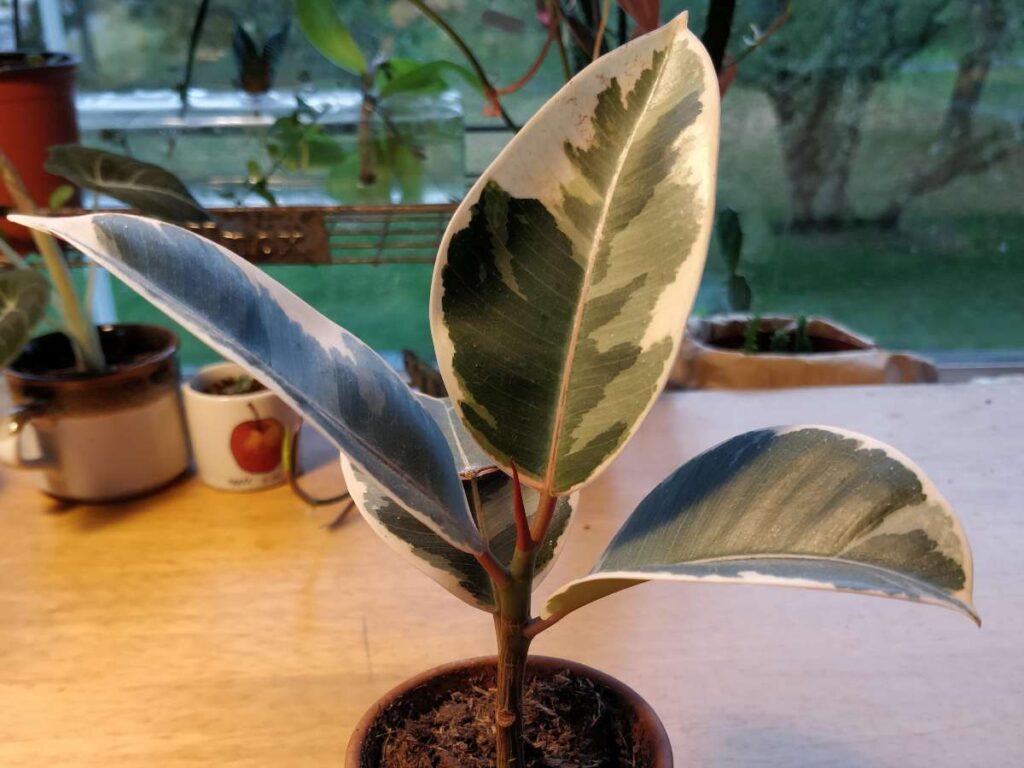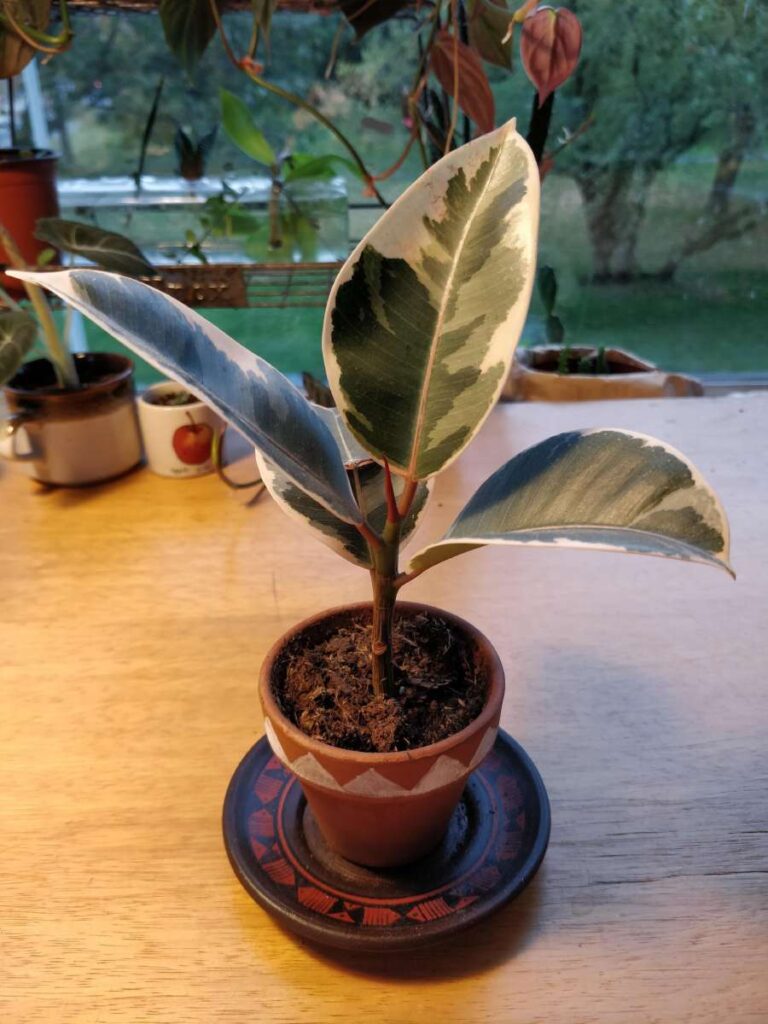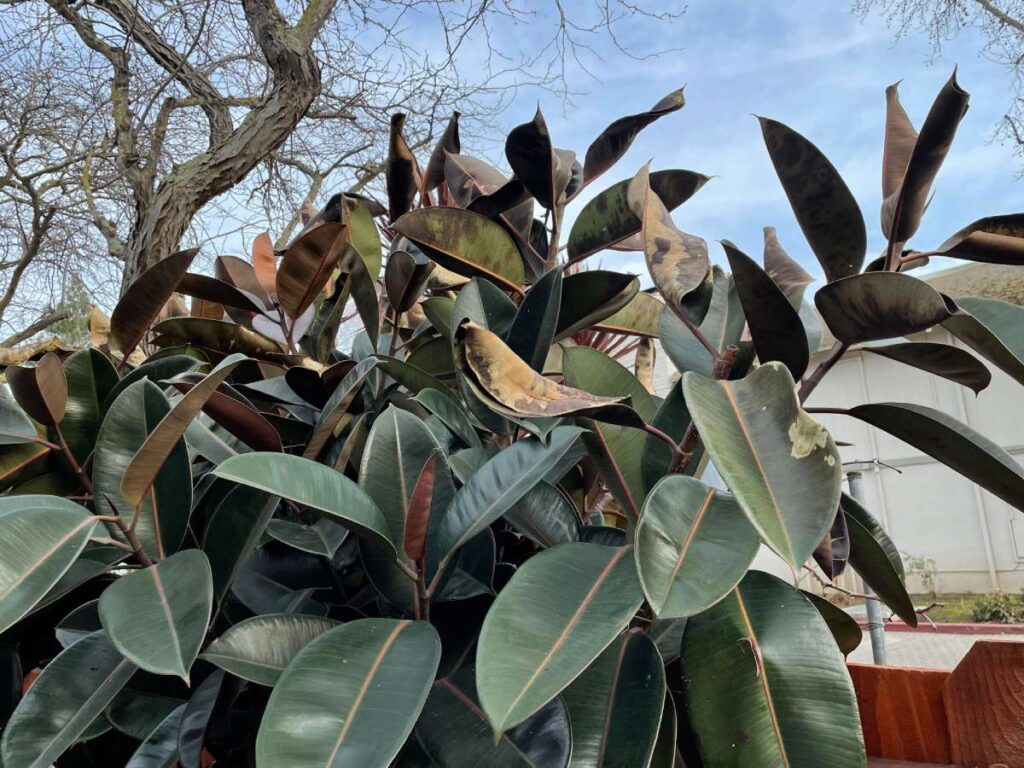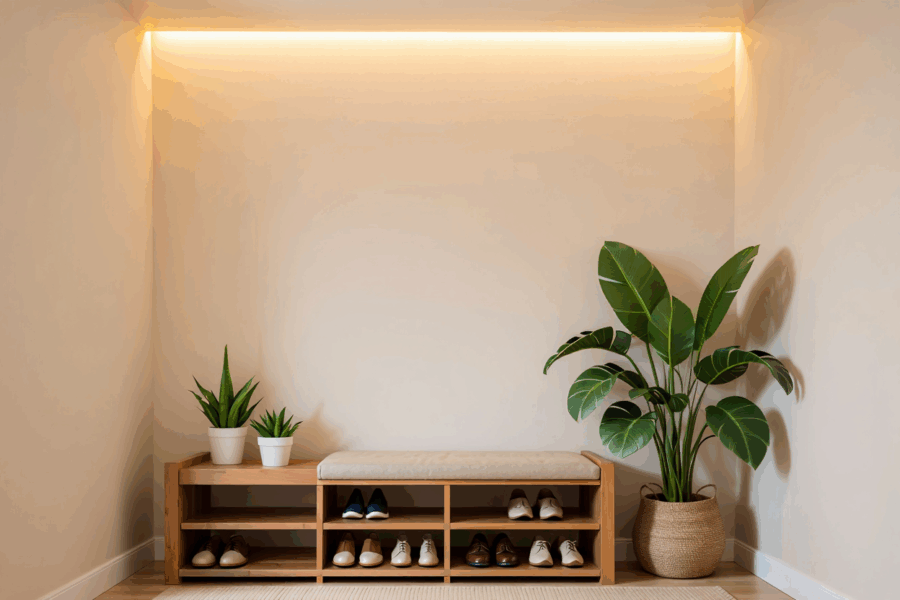Rubber plants are popular houseplants, and they bring life to rooms, but can they live outside? Can you stick one of your rubber plants in the garden and expect it to survive?
Before you put any of your rubber plants outside, it’s essential that you learn how they respond to different climates. There are a few factors involved when it comes to making sure a rubber plant grows well outdoors.
In this article, we’ll explore if rubber plants can survive living outdoors or if sticking one in your garden is not such a good idea after all.
Here’s Can a Rubber Plant Live Outside
A rubber plant can survive in outdoor conditions, but it will require regular watering and plenty of direct sunlight to do so. It is important to note that if the temperatures drop below freezing, the plant could suffer damage or die.

Growing Conditions for A Rubber Plant
First off, rubber plants need plenty of bright but indirect sunlight in order to flourish. They are tropical plants, so they don’t like direct sun and may suffer from leaf scorch if exposed too much.
If you want to grow your rubber plant outdoors, it’s important that it be placed somewhere where it won’t get more than two or three hours of direct sunlight per day. It should also not be put outside during the winter, as temperatures below 10°C could damage the leaves.
It’s also important to take moisture levels into account when growing a rubber plant outside. They prefer consistently moist soil with good drainage, so make sure the area gets enough water without flooding; otherwise, you risk root rot.
To ensure humidity is maintained around the plant, misting its leaves once a week can help keep them looking healthy and vibrant!
Where to Plant a Rubber Plant Outdoors
When it comes to planting a rubber plant outdoors, there are a few considerations that need to be taken into account.
Firstly, you’ll want to make sure your chosen spot is not in direct sunlight; too much sun can cause the leaves to become scorched and dry out.
Secondly, choose an area with well-draining soil; the roots of the rubber tree don’t like soggy conditions!
Here’s a quick list of things to consider when deciding where to put your outdoor rubber plant:
- Pick somewhere sheltered from strong winds or cold drafts.
- Make sure the temperature doesn’t go below 50 degrees Fahrenheit during the winter months.
- Ensure the location gets some indirect sunlight throughout the day, but not all day long.
- Plant your rubber tree in sandy soil that drains quickly; avoid heavy clay soils!
In addition, if you live in an area prone to frost, it would be best to move your Rubber Tree indoors for wintertime as temperatures lower than 50°F may harm the foliage and stunt growth permanently.

Temperature Requirements for Outdoor Rubber Plant
When it comes to outdoor conditions, these plants need warmth! Rubber plants prefer temperatures between 65-85 degrees Fahrenheit (18-29 Celcius). They also require indirect sunlight or bright shade. Too much direct sun can cause scorching on their leaves, so be sure to provide plenty of shade during hot summer days.
In winter months, make sure frost isn’t an issue as temperatures drop below 50°F (10°C); otherwise, your beloved houseplant may not survive the cold outdoors.
TIP: If you live in a cool climate area with long winters, opt for a sheltered spot near the house where temperatures remain more moderate year round.
Light Requirements for Outdoor Rubber Plant
If you want to give your outdoor rubber plant the best chance at flourishing, here are four light requirements that should be met:
- The ideal spot for a rubber plant outdoors would be in full sun or partial shade, which means it should receive 4-6 hours of direct sunlight per day.
- It’s important to remember that if too much sun exposure is given, the leaves might burn and turn yellow.
- Another option is to grow a rubber tree in bright indirect lighting instead of full sun; this will help protect its delicate leaves from burning.
- Lastly, keep your plants away from any heat sources, such as air conditioning vents and radiators, as these can cause leaf damage.
So take into account all of these factors when selecting where to place your beloved outdoor rubber plant; with careful consideration, it will thrive!
Soil Requirements for Outdoor Rubber Plant
When considering if a rubber plant is able to live outside, one of the most important factors to consider is the soil requirements. The right soil will enable it to thrive and be healthy for years to come.
To provide the best care for an outdoor rubber plant, there are several elements that need to be taken into consideration:
- Get a potting mix with good drainage.
- Add some perlite or coarse sand to ensure proper water retention.
- Use a fertilizer specifically designed for indoor/outdoor plants.
- Make sure your pot has plenty of holes in the bottom for optimal draining.
Watering Requirements for Outdoor Rubber Plant
It’s estimated that nearly 50% of houseplant deaths are due to incorrect watering. With this in mind, let’s look at the best way to water our rubber plant when it is placed outdoors.
First off, be aware that your rubber plant will need more frequent watering if kept outdoors than if kept indoors. Outdoor conditions can cause evaporation and temperatures to fluctuate between day and night, which means you’ll need to adjust accordingly.
Aim to check the soil every two days or so by sticking your finger in it up to knuckle depth. If it feels dry, then give it a generous soak until the excess runs out of the bottom drainage hole (if there is one).
Ideally, use rainwater or tap water left overnight before applying, as it removes chlorine and other chemicals present in most municipal supplies.
Be sure not to over-water though, as this can lead to root rot; feeling the soil should help decide how much water is needed each time.
If you’re growing a potted rubber tree outdoors then also consider providing some kind of shelter from heavy rainfalls which could potentially drown the roots leading to premature death.
As long as these needs are met, however, with regular checks on both moisture levels and potential rainy weather, then your outdoor rubber tree should be happy!
Pruning Requirements for Outdoor Rubber Plant
Pruning is an important part of caring for a rubber plant when it’s outdoors. It helps the plant stay healthy and look its best, so I’d recommend doing this regularly.
You should prune dead or broken stems and leaves. This will help get rid of any pests that may have attached themselves to your rubber plant. You can also trim off any branches that are growing at odd angles or are not looking their best.
I would suggest using sharp garden shears for this task, as they won’t damage the plant too much while providing a neat finish.
Don’t forget to keep up with regular pruning throughout the year, especially in the spring, as this will encourage new growth during the warmer months! That way, you can enjoy having a beautiful outdoor rubber plant all season long!
Fertilizing Requirements for Outdoor Rubber Plant
Fertilizing a rubber plant is an essential part of its care routine when planted outdoors, as it helps ensure the health and prosperity of the shrub. Frequent fertilization provides necessary nutrients, enabling foliage to flourish in any environment. Fertilizing your outdoor rubber plant is a fundamental step for keeping it healthy and lush throughout the year.
To begin, select a fertilizer with balanced amounts of nitrogen, phosphorus, and potassium, preferably one designed specifically for potted plants or shrubs.
Applying this fertilizer once every two to three months will help promote strong growth and beautiful greenery.
In addition to regular feeding, watering your outdoor rubber plant correctly can also keep it thriving by ensuring that the soil stays moist without becoming waterlogged.
Keeping these tips in mind when caring for your rubber plant outside helps provide optimal conditions for growth!
Common Problems with Outdoor Rubber Plant
When it comes to having a rubber plant outdoors, there are some common problems that can arise. One of the most frequent issues is a lack of sunlight.
Rubber plants need plenty of bright light in order to thrive and survive outside. If they don’t get enough sun, they may struggle to properly photosynthesize and won’t be able to grow as well as their indoor counterparts.
Another issue is temperature fluctuations. The ideal temperature range for outdoor rubber plants is between 50-85 degrees Fahrenheit. If temperatures dip below this range or go too high, it could cause your rubber plant distress, which might lead to permanent damage like wilting leaves or stunted growth.
Lastly, if you’re not careful with watering your rubber plant, root rot can easily take hold due to overwatering or underwatering. Make sure you know how much water each type of soil requires so that you can keep your outdoor rubber plant healthy.

How to Troubleshoot Outdoor Rubber Plant
First off, be aware of your location and climate. Rubber plants prefer temperate climates with very little sun or humidity.
If either of these conditions exceeds what’s optimal for the plant, then you’ll need to adjust accordingly by providing shade or shelter from the elements.
Additionally, choose an area free from strong gusts of wind, as this could cause damage to their leaves.
Finally, water regularly but carefully; too much moisture can lead to root rot, so ensure drainage is adequate and avoid over-watering your rubber plants at all costs.
As long as you keep up with general maintenance like pruning back dead leaves and removing weeds during the growing season, your outdoor rubber plant should live happily outside!
Managing Pests and Diseases on An Outdoor Rubber Plant
Taking care of an outdoor rubber plant is similar to caring for a newborn baby. It requires patience, attention, and nurturing; if you get it right, the rewards are beautiful! As with any outdoor plants that thrive in warm climates, pests and diseases can be an issue.
Fortunately, there are solutions available to help manage these issues, but they require vigilance and consistency on your part.
Regularly inspect the leaves and stems of your rubber plant for signs of infestation or damage from disease-causing organisms.
Remove affected parts quickly by pruning before the problem spreads throughout your entire plant.
Make sure to use clean tools when trimming away damaged foliage as well.
TIP: Outdoor rubber plants need extra TLC during winter months; make sure to cover them up with frost protection fabric or wrap them in plastic film so they stay healthy all year round.
Benefits of Planting a Rubber Plant Outdoors
For starters, having your own outdoor rubber tree can add an exotic touch to any garden or balcony—it’s almost as if you’ve brought a piece of the tropics with you!
Moreover, since rubber trees thrive in bright but indirect light, they make an excellent addition even to small spaces where direct sunlight wouldn’t be possible.
Furthermore, by growing them yourself, you can ensure that their roots stay healthy while controlling pests and diseases before they become a problem.
Not only this, but having an outdoor rubber tree also allows you to get creative with its shape and size; depending on how much pruning and trimming you do each season, you can create unique shapes like spirals or arches, which will definitely give your garden landscape more character.
Additionally, taking care of a living creature such as a rubber tree adds another level of responsibility to our lives, something we could all use during these tumultuous times. Therefore, why not consider adding one of these majestic creatures to your home?
Potential Drawbacks of Planting a Rubber Plant Outdoors
Like a ship venturing out to sea, planting a rubber plant outdoors can feel like an exciting adventure. But there are potential drawbacks that must be considered before taking the plunge.
Though it might seem ideal for a rubbery shrub to get plenty of natural sunlight and fresh air, this could potentially lead to problems with pests or disease.
If the weather is too hot, dry, or cold for the rubber plant’s liking, then its leaves may start wilting. Even if you provide adequate protection from temperature extremes, an outdoor rubber tree could still suffer from fungal infections caused by excessive dampness in the soil or on the bark and foliage.
And because they tend to attract mealybugs and spider mites when planted outside, regular inspections and treatments will need to be done in order to keep these critters at bay.
Conclusion
When it comes to growing a rubber plant outdoors, the key is understanding its needs and providing those conditions. It’s like baking a cake: you need all the right ingredients for it to turn out perfectly. With patience and dedication, your outdoor rubber plant will thrive!
A well-maintained rubber plant can bring beauty and joy to your garden or patio. Its glossy leaves are an eye catcher that will draw visitors’ attention to your lush vegetation. Taking care of this low-maintenance houseplant outside gives you the opportunity to admire its elegant appearance as often as you want.
Growing a rubber plant outdoors requires giving it everything it needs, from adequate sunlight to nutrient-rich soil, but if done correctly, the rewards are bountiful. Just imagine how beautiful your garden could look with one of these plants gracing its presence—like adding icing on top of a delicious cake!









